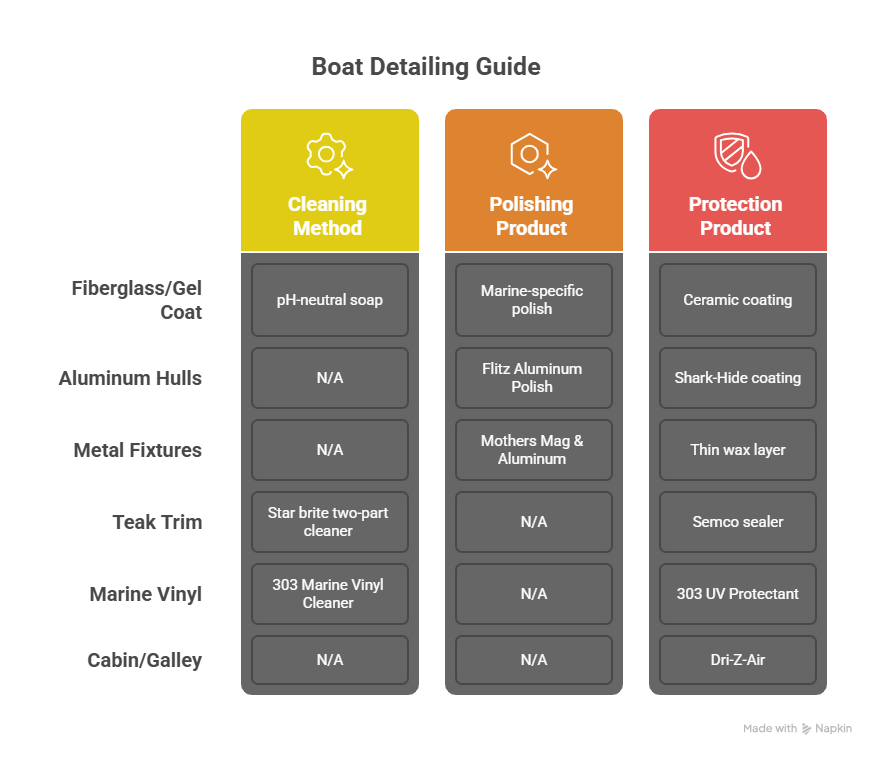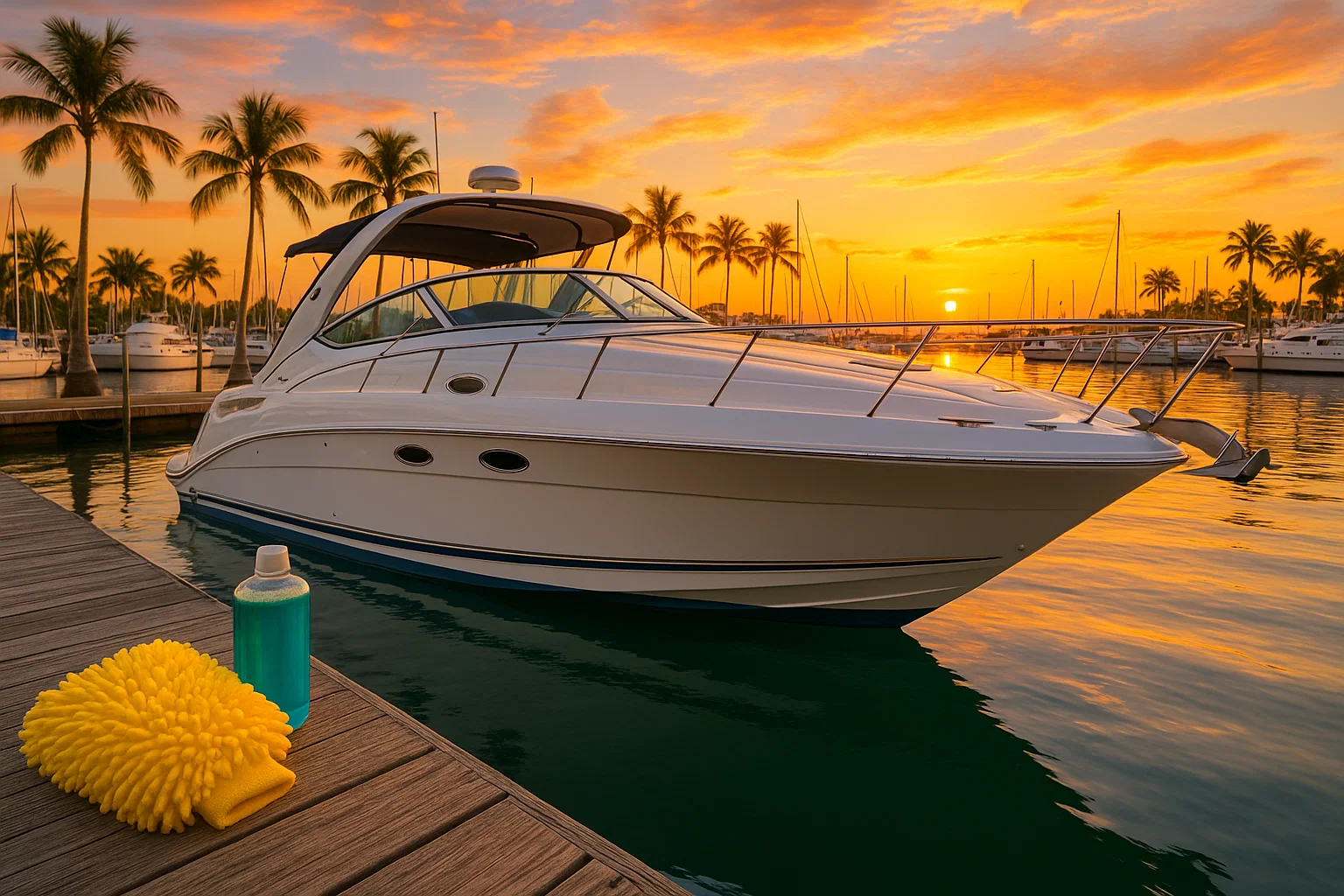Boat Detailing: My Secrets to a Showroom Shine in South Florida
I’ve been detailing boats in Miami for 15 years, and let me tell you, nothing beats the feeling of stepping onto a vessel that gleams like it just rolled out of the showroom. I started helping my dad polish our old Boston Whaler in the ‘90s, got my ABYC certification in 2010, and now detail boats from Key Biscayne to Fort Lauderdale. Last July, a client named Javier brought his Sea Ray 350 to Dinner Key Marina, complaining about “stubborn waterline scum.” It wasn’t just scum—it was a mix of algae and rust that took $200 in specialized cleaners to fix. Here’s my proven process to transform your boat from clean to pristine, protect it from South Florida’s brutal sun and salt, and keep it looking sharp all season.
Table of Contents
Why Does Boat Detailing Matter in South Florida?
South Florida’s sun, salt, and humidity are a boat’s worst enemies. Without proper detailing, your gel coat oxidizes, vinyl cracks, and metal pits—costing thousands in repairs. I’ve seen boats lose 20% of their resale value from neglect. Detailing isn’t just about looks; it’s about preserving your investment. Let’s dive into the techniques that get it right.
How Do I Start Detailing My Boat Without Scratching It?
The foundation of a great detail is a proper wash. Mess this up, and you’re grinding dirt into your gel coat, creating swirl marks that’ll haunt you later. Here’s how I do it.
Step 1: The Diagnostic Rinse
Before soap touches the boat, I rinse from top to bottom—flybridge to hull—using gravity to flush dirt away. I use a hose with a 40-degree nozzle, keeping pressure low to avoid damaging decals. Last summer at Stiltsville, I spotted rust stains on a client’s Grady-White during the rinse—saved us hours by catching it early.
Step 2: Pre-Treating Tough Stains
South Florida’s waterline scum is brutal. I hit it with a hull cleaner like Star brite, letting it sit for 5 minutes to dissolve algae. For black streaks, I use a marine degreaser—worked like a charm on a Bayliner 285 last month. Rust stains? Oxalic acid cleaner, applied carefully, does the trick.
Step 3: Two-Bucket Wash Method
Never use one bucket. I learned this the hard way after scratching my dad’s Whaler in ‘98. One bucket’s for marine soap (Meguiar’s Marine is my go-to), the other’s clean water to rinse the mitt. I use a plush microfiber mitt for gel coat and a soft-bristle brush for non-skid decks. This method’s saved me from countless swirl marks.
How Do I Restore a Boat’s Shine?
A clean boat’s nice, but a polished one turns heads. Correction removes oxidation, swirls, and scratches to bring back that wet-look gloss.
Compounding vs. Polishing: What’s the Difference?
Compounding’s heavy-duty—it’s like sandpaper for serious oxidation or scratches. I used 3M Marine Compound on a weathered Sea Ray last June, took off chalkiness in two hours. Polishing’s gentler, refining the surface for a mirror shine. I follow up with Meguiar’s Marine Polish—makes the gel coat pop.
Why Use a Dual-Action Polisher?
Hand-polishing’s a workout, and it’s inconsistent. A Dual-Action (DA) polisher, like my Rupes LHR 15, is safer for DIYers and cuts time in half. I work 2×2-foot sections, using a foam cutting pad for compound and a soft pad for polish, overlapping passes for a uniform finish. Saved a client’s Hatteras $500 in labor last spring.
Should I Use a Clay Bar?
If the gel coat feels gritty after washing, a clay bar’s a must. I used one on a client’s Pursuit at Coconut Grove—removed bonded salt spray in 30 minutes. Spray a lubricant like Meguiar’s Quick Detailer, glide the clay, and wipe clean. It’s like giving your boat a smooth canvas.

What’s the Best Way to Protect My Boat’s Finish?
Polishing gets you shine, but protection locks it in. South Florida’s UV rays and salt can dull a finish in months without the right barrier.
Wax, Sealant, or Ceramic Coating?
- Wax: Carnauba-based waxes (e.g., Collinite 925) give a warm glow but last 2–4 months. Great for weekend warriors who love reapplying.
- Sealant: Polymer sealants (e.g., Star brite Premium) last 6–12 months, offering solid UV protection. I used one on a Bertram 390 last year—still glossy after 10 months.
- Ceramic Coating: The gold standard, like Gtechniq Marine, lasts 2+ years with insane water-beading. Cost me $800 to coat a client’s Intrepid, but it’s worth it for low maintenance.
How Do I Apply Protection Right?
Prep’s everything. I wipe the surface with isopropyl alcohol to remove polish oils—learned this after a sealant failed on a buddy’s boat in 2019. Apply thin layers with a foam applicator, let it haze (per instructions), then buff off. For ceramics, I wait 24 hours before water exposure. Skimp here, and you’re wasting your work.
How Do I Detail Different Boat Surfaces?
Boats aren’t one material. Using the wrong product can ruin your finish. Here’s how I handle each surface.
Fiberglass and Gel Coat
Gel coat’s tough but oxidizes fast in Miami’s sun. I clean with pH-neutral soap, polish with marine-specific products, and seal with a ceramic coating for max UV protection. A client’s Viking 52 looked brand-new after this process last July.
Aluminum Hulls
Aluminum pontoons pit without care. I polish with Flitz Aluminum Polish—took three hours to restore a client’s pontoon at Key Biscayne. A Shark-Hide coating adds months of protection against saltwater corrosion.
Metal Fixtures
Stainless steel cleats and chrome railings need regular love. I polish with Mothers Mag & Aluminum, using a drill-mounted cone for tight spots. A thin wax layer slows rust—saved a client’s brass fittings at Bahia Mar last month.
Teak Trim
Teak’s gorgeous but high-maintenance. I use Star brite’s two-part cleaner to strip gray weathering, then apply a sealer like Semco for year-long protection. Did this for a yacht at Fort Lauderdale’s Pier 66—looked like new wood.
How Do I Keep the Interior Spotless?
Interiors take a beating from sun, salt, and humidity. A clean cabin and vinyl keep your boat inviting and valuable.
Cleaning Marine Vinyl
Vinyl seats crack without care. I use 303 Marine Vinyl Cleaner with a soft brush to lift sunscreen and salt. Last summer, I saved a client’s faded cushions at Stiltsville with 303 UV Protectant—reapply every 4–6 weeks to block UV damage.
Cabin and Galley Care
Cabins get musty fast. I wipe headliners, vacuum carpets, and use Dri-Z-Air to control moisture. A client’s Hatteras cabin smelled fresh after this routine last June. Open hatches when possible to keep air flowing.

FAQ: Common Boat Detailing Questions
How Often Should I Detail My Boat?
I detail my boat every 3 months in peak season—March to August in South Florida. A full wash, polish, and wax takes 6–8 hours but keeps the finish pristine. For quick upkeep, rinse and spot-clean weekly.
What’s the Best Product for Waterline Scum?
Star brite Hull Cleaner’s my go-to. I applied it to a Sea Ray’s “boat beard” last July, let it sit for 5 minutes, and scrubbed—gone in 10 minutes. Always rinse thoroughly to avoid streaks.
Can I Use Car Products on My Boat?
Big mistake. Car soaps and waxes aren’t built for gel coat or saltwater. I tried a car polish on a buddy’s boat in 2012—dulled the finish. Stick to marine products like Meguiar’s or 3M.
How Do I Prevent Vinyl Cracking?
UV protectant’s non-negotiable. I use 303 Aerospace Protectant every 4 weeks—saved a client’s seats from cracking at Coconut Grove. Clean with a marine vinyl cleaner first to ensure adhesion.
Is a Ceramic Coating Worth It?
For heavy-use boats, absolutely. I coated a client’s Intrepid with Gtechniq Marine in 2024—$800 but two years of protection. It repels water like magic, cutting cleaning time in half.
How Do I Maintain Teak Without Sanding?
Use a two-part teak cleaner like Star brite. I restored a yacht’s teak at Pier 66 last spring—no sanding needed. Seal with Semco for a year of protection; reapply every 6–12 months.
Why Do My Metal Fixtures Rust?
Salt air’s the culprit. I polish with Mothers Mag & Aluminum monthly and add a wax layer—kept a client’s cleats rust-free at Bahia Mar. Neglect them, and you’re looking at $200 replacements.
How Do I Keep My Cabin Mildew-Free?
Moisture control’s key. I use Dri-Z-Air in closed cabins and open hatches when docked. Vacuum and wipe surfaces weekly—saved a Hatteras from mildew last June.
Table: My Go-To Boat Detailing Tools and Products
I compiled this from my last five detailing jobs in Miami:
| Product/Tool | Use Case | Cost | Where to Buy |
|---|---|---|---|
| Meguiar’s Marine Soap | Washing gel coat, non-skid | $15 | West Marine |
| Star brite Hull Cleaner | Removing waterline scum | $20 | Amazon |
| Rupes LHR 15 Polisher | Compounding and polishing | $400 | Marine stores |
| 303 UV Protectant | Protecting vinyl from UV damage | $25 | West Marine |
| Gtechniq Marine Coating | Long-term gel coat protection | $100 | Online |
Conclusion
Detailing your boat isn’t just about a shiny hull—it’s about protecting your investment from South Florida’s relentless sun and salt. I’ve seen neglected boats lose thousands in value, but a few smart techniques can keep yours pristine. Start with the two-bucket wash to avoid scratches, use a DA polisher for a mirror shine, and apply UV protectant to save your vinyl. Match products to each surface—gel coat, aluminum, teak—and you’ll avoid costly damage. Next time you’re at the dock, rinse your boat and tackle one problem spot. That small win builds momentum for a vessel that turns heads and holds its value all season.
Author Bio
I’m Alex, a 15-year marine detailing expert based in Miami, with ABYC certification and 200+ boats detailed, from Sea Rays to Vikings. I’ve honed my craft in South Florida’s toughest conditions, saving clients thousands in repairs.


Leave a Reply